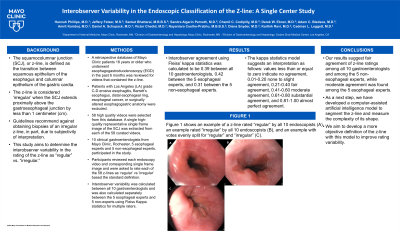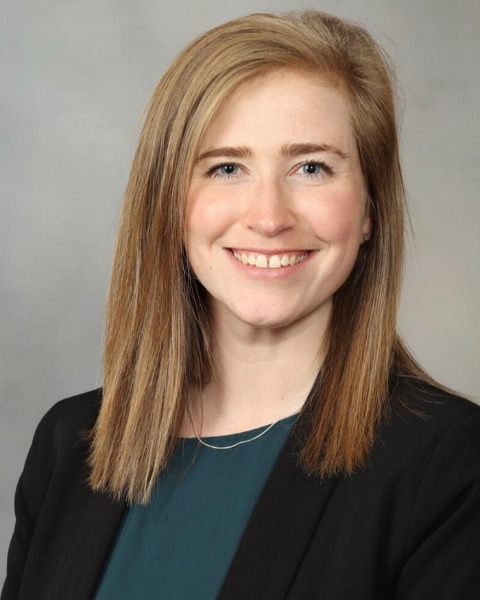Tuesday Poster Session
Category: Esophagus
P3906 - Interobserver Variability in the Endoscopic Grading of the Z-Line: A Single-Center Study
Tuesday, October 29, 2024
10:30 AM - 4:00 PM ET
Location: Exhibit Hall E

Has Audio

Hannah Phillips, MD
Mayo Clinic School of Graduate Medical Education
Rochester, MN
Presenting Author(s)
Hannah Phillips, MD1, Jeffrey Fetzer, MS2, Sanket Bhattarai, MBBS2, Sandra Algarin Perneth, MD2, Don C.. Codipilly, MD2, Adam Bledsoe, MD2, Derek W. Ebner, MD2, Amrit K.. Kamboj, MD3, Cadman Leggett, MD2
1Mayo Clinic School of Graduate Medical Education, Rochester, MN; 2Mayo Clinic, Rochester, MN; 3Cedars-Sinai Medical Center, Los Angeles, CA
Introduction: In the absence of Barrett’s esophagus (BE), the squamocolumnar junction (SCJ), or z-line, is defined as the transition between the squamous mucosa of the esophagus and columnar mucosa of the gastric cardia. The z-line is considered ‘irregular’ when the SCJ extends proximally above the gastroesophageal junction by less than 1 centimeter (cm). The classification of the z-line is primarily performed by visual inspection and rarely by direct measurement. Gastroenterology society guidelines recommend against obtaining routine biopsies of an irregular z-line, in part, due to subjectivity of interpretation. This study aims to determine the interobserver variability in the rating of the z-line as ‘regular’ vs ‘irregular.’
Methods: The endoscopy video library of the Division of Gastroenterology and Hepatology at Mayo Clinic, Rochester was reviewed for patients 18 years or older who underwent routine clinical esophagogastroduodenoscopy (EGD) over the past 6 months. Exclusion criteria included the presence of Los Angeles (LA) grade C-D erosive esophagitis, BE, distal esophageal ring, esophageal cancer, or surgically altered esophagogastric anatomy. Videos were clipped to contain frames that clearly visualized the z-line. In addition, a representative single frame image was selected that included the entire z-line with the endoscope located approximately 2-3 above the SCJ. Five clinical gastroenterologists from Mayo Clinic, Rochester who perform greater > 100 EGDs per year were invited to participate in the study. Participants reviewed each video and corresponding single frame image and were asked to rate each z-line as ‘regular’ vs ‘irregular’ based the standard aforementioned definition. The interobserver variability was calculated using Fleiss’ kappa statistics for multiple raters.
Results: The rating dataset consisted of 58 video and image pairs. Moderate agreement was observed between the 5 endoscopists (kappa 0.41) when rating the z-line as ‘regular’ vs ‘irregular’ using this dataset.
Discussion: Classification of the z-line as regular vs irregular by experienced endoscopists reached moderate agreement in a randomly selected dataset of high-quality videos with corresponding single frame images. Rating of the z-line was performed by visual interpretation, not by direct measurement, which is consistent with routine clinical practice. As next steps, we aim to explore factors associated with the visual classification of the z-line (i.e. SCJ shape) and establish methodology for standardization.
Disclosures:
Hannah Phillips, MD1, Jeffrey Fetzer, MS2, Sanket Bhattarai, MBBS2, Sandra Algarin Perneth, MD2, Don C.. Codipilly, MD2, Adam Bledsoe, MD2, Derek W. Ebner, MD2, Amrit K.. Kamboj, MD3, Cadman Leggett, MD2. P3906 - Interobserver Variability in the Endoscopic Grading of the Z-Line: A Single-Center Study, ACG 2024 Annual Scientific Meeting Abstracts. Philadelphia, PA: American College of Gastroenterology.
1Mayo Clinic School of Graduate Medical Education, Rochester, MN; 2Mayo Clinic, Rochester, MN; 3Cedars-Sinai Medical Center, Los Angeles, CA
Introduction: In the absence of Barrett’s esophagus (BE), the squamocolumnar junction (SCJ), or z-line, is defined as the transition between the squamous mucosa of the esophagus and columnar mucosa of the gastric cardia. The z-line is considered ‘irregular’ when the SCJ extends proximally above the gastroesophageal junction by less than 1 centimeter (cm). The classification of the z-line is primarily performed by visual inspection and rarely by direct measurement. Gastroenterology society guidelines recommend against obtaining routine biopsies of an irregular z-line, in part, due to subjectivity of interpretation. This study aims to determine the interobserver variability in the rating of the z-line as ‘regular’ vs ‘irregular.’
Methods: The endoscopy video library of the Division of Gastroenterology and Hepatology at Mayo Clinic, Rochester was reviewed for patients 18 years or older who underwent routine clinical esophagogastroduodenoscopy (EGD) over the past 6 months. Exclusion criteria included the presence of Los Angeles (LA) grade C-D erosive esophagitis, BE, distal esophageal ring, esophageal cancer, or surgically altered esophagogastric anatomy. Videos were clipped to contain frames that clearly visualized the z-line. In addition, a representative single frame image was selected that included the entire z-line with the endoscope located approximately 2-3 above the SCJ. Five clinical gastroenterologists from Mayo Clinic, Rochester who perform greater > 100 EGDs per year were invited to participate in the study. Participants reviewed each video and corresponding single frame image and were asked to rate each z-line as ‘regular’ vs ‘irregular’ based the standard aforementioned definition. The interobserver variability was calculated using Fleiss’ kappa statistics for multiple raters.
Results: The rating dataset consisted of 58 video and image pairs. Moderate agreement was observed between the 5 endoscopists (kappa 0.41) when rating the z-line as ‘regular’ vs ‘irregular’ using this dataset.
Discussion: Classification of the z-line as regular vs irregular by experienced endoscopists reached moderate agreement in a randomly selected dataset of high-quality videos with corresponding single frame images. Rating of the z-line was performed by visual interpretation, not by direct measurement, which is consistent with routine clinical practice. As next steps, we aim to explore factors associated with the visual classification of the z-line (i.e. SCJ shape) and establish methodology for standardization.
Disclosures:
Hannah Phillips indicated no relevant financial relationships.
Jeffrey Fetzer indicated no relevant financial relationships.
Sanket Bhattarai indicated no relevant financial relationships.
Sandra Algarin Perneth indicated no relevant financial relationships.
Don Codipilly indicated no relevant financial relationships.
Adam Bledsoe: Chugai Pharma – Grant/Research Support. Kanyos Bio – Grant/Research Support.
Derek Ebner: Exact Sciences – Consultant, Independent Contractor.
Amrit Kamboj: Castle Biosciences – Consultant.
Cadman Leggett: Castle Biosciences – Consultant.
Hannah Phillips, MD1, Jeffrey Fetzer, MS2, Sanket Bhattarai, MBBS2, Sandra Algarin Perneth, MD2, Don C.. Codipilly, MD2, Adam Bledsoe, MD2, Derek W. Ebner, MD2, Amrit K.. Kamboj, MD3, Cadman Leggett, MD2. P3906 - Interobserver Variability in the Endoscopic Grading of the Z-Line: A Single-Center Study, ACG 2024 Annual Scientific Meeting Abstracts. Philadelphia, PA: American College of Gastroenterology.
